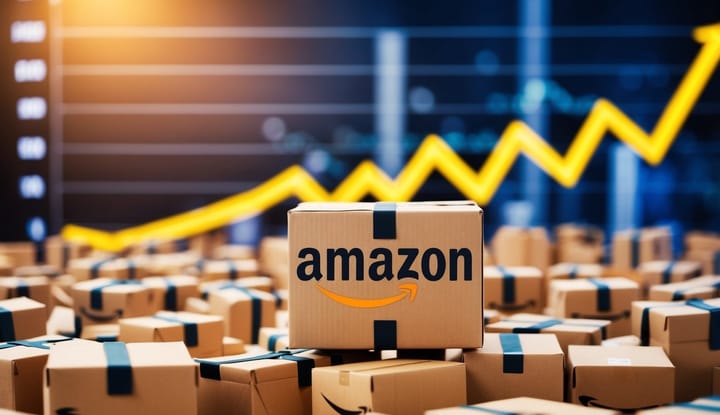Crush Your Day: Seven Time Hacks for Amazon Sellers

Running a successful Amazon business demands smart time management to stay ahead in the competitive marketplace. Many sellers struggle to balance essential tasks like inventory management, customer service, and marketing while maintaining profitability. Effective time management starts with setting clear priorities and focusing on tasks that directly impact business growth.

Time is a precious resource for Amazon sellers who need to handle multiple responsibilities each day. Smart automation tools and structured workflows can help sellers reduce manual work and focus on strategic activities that boost sales performance.
Key Takeaways
- Setting clear priorities and goals helps sellers focus on high-impact business activities
- Automation tools streamline repetitive tasks and increase operational efficiency
- Structured workflows and systems maximize productivity while reducing time waste
Mastering Core Time Management Principles
Effective time management creates the foundation for Amazon seller success. Smart planning and focused execution help sellers maximize their productivity while maintaining work-life balance.
Setting Clear Business Goals
Amazon sellers need specific, measurable goals to guide their daily actions. Start by setting both short-term and long-term targets for sales, profit margins, and inventory levels.
Break larger goals into smaller weekly and monthly milestones. For example, aim to list 10 new products each week or maintain a 30-day inventory turnover rate.
Track progress using simple metrics like:
- Monthly revenue targets
- Number of positive reviews
- Inventory stockout rates
- Average order fulfillment time
Prioritizing High-Impact Tasks
Create a daily task list ranked by importance and revenue potential. Focus on activities that directly boost sales and profitability.
High-priority tasks include:
- Responding to customer messages within 24 hours
- Monitoring and adjusting pricing
- Managing inventory levels
- Analyzing competitor offerings
Use the 80/20 rule: Spend most time on the 20% of tasks that generate 80% of results.
Leveraging Time Blocking Techniques
Assign specific time slots to different business activities. This reduces task-switching and increases focus.
Sample time blocking schedule:
- 8-9 AM: Review metrics and plan day
- 9-11 AM: Product research and sourcing
- 1-2 PM: Customer service
- 2-4 PM: Listing optimization
Group similar tasks together to maintain momentum. Set boundaries by scheduling breaks between blocks.
Protect focused work time by turning off notifications during important tasks.
Streamlining Inventory And Fulfillment Processes

Smart inventory management and efficient fulfillment systems help Amazon sellers maximize profits while reducing costs. Using the right tools and strategies keeps stock levels balanced and orders flowing smoothly.
Automating Inventory Management
Inventory management software like InventoryLab connects directly with Amazon Seller Central to track stock levels in real-time. These tools generate automatic reorder alerts when inventory drops below set thresholds.
Regular stock audits help prevent costly stockouts and overstock situations. Setting up min/max inventory levels for each SKU ensures optimal stock quantities.
Automated repricing tools adjust product prices based on market conditions and competitor pricing. This helps maintain healthy sell-through rates and profit margins.
Preventing And Resolving Stranded Inventory
Stranded inventory occurs when FBA items can't be sold due to listing or compliance issues. Regular checks in Seller Central identify stranded inventory before it impacts sales.
Common causes of stranded inventory:
- Expired products
- Damaged packaging
- Missing product information
- Category restrictions
Quick removal or disposal of stranded items reduces storage fees. Creating detailed product listings with complete information prevents many stranding issues.
Optimizing Multi-Channel Fulfillment
FBA Multi-Channel Fulfillment lets sellers use Amazon's warehouses to fulfill orders from other sales channels. This reduces shipping costs and delivery times.
Setting inventory allocation rules ensures enough stock for each channel. Reserve buffers help prevent stockouts during high-demand periods.
Integration tools connect marketplace listings to maintain accurate inventory levels. Automated order routing sends orders to the optimal fulfillment center based on location and stock availability.
Optimizing Listing, Marketing, And Research Activities

Smart optimization of product listings and marketing activities helps Amazon sellers reach more customers and increase sales. The right mix of product research, listing optimization, and strategic advertising creates a strong foundation for success.
Efficient Product Research And Sourcing
Product research tools like JungleScout and Helium10 help sellers identify profitable opportunities. These tools provide vital data on sales volume, competition, and market trends.
Regular market analysis reveals seasonal patterns and emerging customer needs. Tracking competitor pricing and inventory levels guides smart sourcing decisions.
Creating a systematic research process saves time. A simple spreadsheet to track product metrics, costs, and profit margins keeps data organized.
Creating High-Converting Product Listings
Clear, benefit-focused product titles grab attention and include relevant keywords. Bullet points highlight key features and address common customer questions.
High-quality images show products from multiple angles. Lifestyle photos demonstrate the product in use.
A+ content enhances product descriptions with rich media and comparison charts. This premium content builds trust and reduces returns.
Keyword research tools identify high-traffic search terms. Strategic keyword placement in titles, bullets, and backend search terms improves visibility.
Implementing Effective Marketing Strategies
Email campaigns keep customers engaged after purchase. Automated follow-up messages encourage reviews and repeat purchases.
Social media showcases products to new audiences. Regular posts with lifestyle images and customer testimonials build brand awareness.
Promotional campaigns during peak shopping seasons capture increased traffic. Bundle deals and limited-time offers create urgency.
Leveraging Sponsored Products And Brands
Sponsored Product ads place items in prominent search positions. Data-driven keyword selection targets ready-to-buy customers.
Sponsored Brands ads build brand recognition with custom headlines and logos. These ads direct shoppers to curated product collections.
Regular bid adjustments optimize ad spend. Performance metrics guide budget allocation across campaigns.
Campaign reports reveal top-converting keywords. This data improves organic listings and future ad targeting.
Enhancing Customer Service And Feedback Workflows
Professional customer service drives success on Amazon by building trust and encouraging repeat purchases. Quick response times and personalized support help sellers stand out in a competitive marketplace.
Responding To Customer Inquiries Efficiently
The Amazon Seller App enables quick responses to customer messages from any location. Sellers should aim to answer questions within 24 hours to maintain high performance metrics.
Creating templated responses for common questions saves time while maintaining a personal touch. These templates should address frequent concerns about shipping, returns, and product specifications.
A clear system for tracking customer conversations prevents missed messages. Many sellers use color-coding or folders to organize inquiries by urgency and status.
Managing And Leveraging Customer Feedback
Setting up automated feedback requests helps gather more customer reviews. The timing of these requests matters - sending them 5-7 days after delivery often yields better results.
Negative feedback requires immediate attention. Sellers should address concerns professionally and work to resolve issues quickly.
Key feedback metrics to monitor:
- Product rating trends
- Response time average
- Resolution success rate
- Return reason patterns
Building Loyalty And Repeat Business
Amazon Pay simplifies the checkout process for returning customers. Sellers can encourage repeat purchases by including thank-you notes with orders.
Quality packaging and accurate product descriptions reduce returns and increase customer satisfaction. Small touches like branded inserts or bonus samples can make customers feel valued.
Following up on successful purchases with relevant product recommendations helps drive additional sales. Sellers should track purchase patterns to identify opportunities for cross-selling.
Maximizing Productivity And Profitability Through Tools And Delegation
Smart tools and delegation strategies help Amazon sellers save time while increasing sales and profits. The right combination of analytics, outsourcing, and pricing optimization creates a more efficient business operation.
Utilizing Analytics And Performance Metrics
Amazon seller analytics tools provide crucial data about sales trends, inventory levels, and competitor pricing. Sellers should check key metrics like Buy Box win rate, conversion rates, and profit margins daily.
Tools like Inventory Management solutions help prevent stockouts and overstock situations. They calculate optimal reorder points based on historical sales data.
Essential metrics to track:
- Return on investment (ROI)
- Advertising cost of sales (ACoS)
- Best and worst performing products
- Customer reviews and ratings
- Page views and conversion rates
Outsourcing Routine Tasks
Many Amazon tasks can be delegated to virtual assistants or specialized services. This frees up time for strategic business decisions.
Common tasks to outsource:
- Product listing optimization
- Customer service responses
- Order processing
- Image editing
- Inventory management
- Social media marketing
Virtual assistants can handle routine communication and administrative work for 2-3 hours per day. This allows sellers to focus on growth strategies.
Managing Accounting And Pricing Strategies
Automated accounting software tracks expenses, revenue, and profitability for each product. Regular financial review helps identify areas for cost reduction.
Pricing tools monitor competitor prices and automatically adjust listings to maintain profits. Dynamic pricing strategies help win the Buy Box without sacrificing margins.
Keep detailed records of:
- Product costs
- Amazon fees
- Shipping expenses
- Marketing costs
- Net profit per SKU
Adjusting For Better Profitability
Small changes in operations can significantly impact bottom-line profits. Testing different pricing points helps find the optimal balance between sales volume and margins.
Regular product performance reviews identify items needing optimization or removal from inventory. Low-performing products drain resources and attention.
Consider these profit-boosting tactics:
- Bundle complementary products
- Optimize product titles and descriptions
- Improve product images
- Test price points
- Remove underperforming items
Frequently Asked Questions

Time management, revenue growth, and inventory control form the foundation of a thriving Amazon business. Smart pricing and fulfillment choices help sellers stand out while delivering excellent customer service.
Q: What strategies can I employ to optimize my handling time for improved customer satisfaction?
Creating templates for common customer messages saves significant time during communication. Setting specific blocks of time for order processing helps maintain consistent shipping speeds.
Using automated responses for basic inquiries allows sellers to focus on complex customer needs. A well-organized workspace with proper packing materials keeps fulfillment efficient.
Q: How can one consistently generate at least $1000 in monthly revenue from Amazon selling?
Product research tools identify profitable niches with steady demand. Sellers should focus on items with healthy profit margins between 25-35%.
Marketing through ads and optimized listings increases visibility. Building a diverse product catalog reduces reliance on single item performance.
Q: What are effective techniques for inventory management to maintain a profitable Amazon store?
Regular sales data analysis helps predict seasonal trends and reorder points. Smart inventory forecasting prevents stockouts while minimizing storage fees.
Using inventory management software tracks stock levels automatically. Setting par levels for each product ensures timely reordering.
Q: What sets a top-performing Amazon seller apart from the competition?
Strong customer service practices lead to positive reviews and repeat buyers. Quick response times to messages and concerns build trust.
Professional product photography and detailed listings attract more customers. Regular price monitoring keeps offerings competitive in the marketplace.
Q: How can leveraging Amazon Prime improve my sales and customer experience?
FBA enrollment makes products Prime-eligible, increasing visibility to millions of Prime members. Prime badges boost consumer confidence and purchase likelihood.
Fast Prime shipping speeds lead to higher customer satisfaction rates. The FBA program handles storage, shipping, and customer service tasks.
Q: What best practices should I follow for setting competitive prices on Amazon?
Regular competitor price monitoring helps maintain market relevance. Automated repricing tools adjust prices within preset profit margins.
Considering all costs including FBA fees ensures sustainable pricing strategies. Bundle offers and quantity discounts can increase average order value.
Q: What are some time management tips for Amazon sellers?
To crush your day, prioritize tasks, set specific goals, and use tools that help automate processes. Managing your time effectively can make a huge difference in how you sell on Amazon.
Q: How can I improve my product description to boost sales?
Focus on writing high-quality product descriptions that highlight the benefits and features of your products. Use relevant keywords to optimize for search results, which can help your listings stand out.
Q: What are the best tips for selling on Amazon if I'm a new seller?
Start with thorough research on your niche, understand your competition, and optimize your Amazon listing with effective keywords. Leverage Amazon FBA to simplify fulfillment and handling returns.
Q: How do customer reviews impact my successful Amazon business?
Customer reviews can make or break your sales on Amazon. Positive reviews build trust and improve your ranking in search results, while negative ones can deter potential buyers. Encourage satisfied customers to leave feedback!
Q: What’s the deal with the Buy Box, and how do I get it?
The Buy Box is that sweet spot on the product detail page where buyers can add items to their cart. To win it, you need to be a competitive Amazon FBA seller with good pricing, stock availability, and great customer service.
Q: What are some effective selling strategies for boosting sales on Amazon?
Consider diversifying your product range, using Amazon advertising to reach a wider audience, and implementing seasonal promotions. Tracking trends can also help you adjust your strategy for maximum impact.
Q: How do I manage my Amazon inventory efficiently?
An effective inventory management strategy includes regularly checking your stock levels, using tools that automate reordering, and analyzing sales trends to forecast demand. Staying on top of your inventory helps prevent stockouts.
Q: What keywords should I focus on for my Amazon listings?
Research keywords related to your products on Amazon, and look for terms that your target customers are searching for. Use these keywords in your product title and description to improve visibility and boost sales.
Q: How can Amazon advertising help grow my Amazon business?
Amazon advertising allows you to promote your products on the platform, helping you reach potential buyers who may not find your listings otherwise. Setting up ads can significantly increase your visibility and drive sales.
Q: What are some tips to boost sales for my Amazon FBA business?
To boost sales, optimize your listings with high-quality images and compelling descriptions, actively manage your customer reviews, and utilize promotions and discounts during peak shopping seasons.
Ready to Take Control of Your Time—and Your Amazon Sales?
Join our mini-course at WAH Academy and learn time-saving strategies that actually work. From smarter inventory management to listing optimization, we’ll help you reclaim your day and grow your sales.
No fluff. No burnout. Just real tools to help you work less and earn more.
Tap the button and start building a more efficient Amazon business today.



